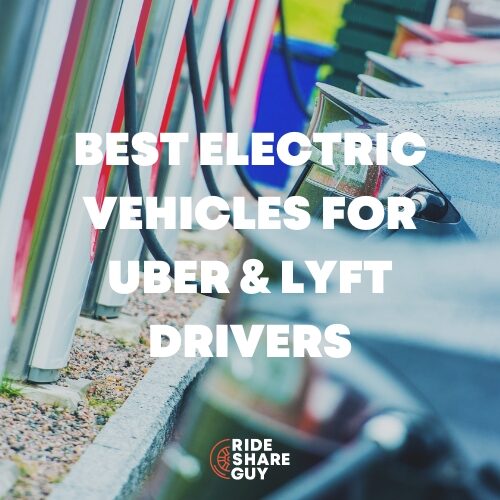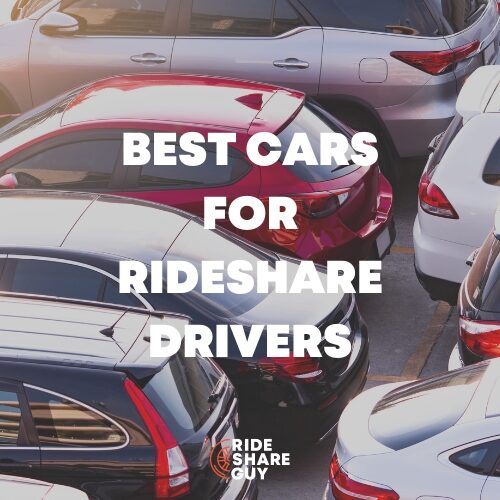Want to get in on the whole EV thing, but don’t want to shell out massive bucks for a new Tesla or other new vehicle? Senior RSG contributor Gabe Ets-Hokin covers all the ways you can rent out an electric vehicle for rideshare driving, and why you might want to!
Electric vehicles—EVs—are in the news a lot these days, with Tesla Motors now worth a trillion dollars, Rivian stock going crazy and Hertz car rental’s purchase of 100,000 Teslas making national headline news. The waitlist at dealers for the hottest new EVs from Ford, Volkswagen, Audi, Hyundai, Kia and others is long—demand for these cars is through the roof.
Why? Well, that may be of interest to a rideshare or other gig-work driver. We’ve covered why you might want to drive an electric vehicle for Uber in the past, and the benefits are clear.
EVs are:
- less than half the cost to operate
- require very little maintenance
- are fun to drive
- quiet for passengers
- (if you care about such things) greatly reduce our personal emissions of greenhouse gasses
Plus, passengers love them.
One big problem is the high cost of entry. Used EVs are few and far between and the new ones, even if available, are almost all north of $33,000.
A solution? Try renting one for a while to see if the EV lifestyle—because owning an EV is a lifestyle choice in some ways—works with your particular gig and how you do it. Read on!
What’s an Electric Vehicle (EV)?
If you’re not quite sure what an EV is, don’t worry—it’s a confusing and fairly technical area. Strictly speaking, an EV has the ability to be driven by an electric motor, so the category includes hybrids, plug-in hybrids, fuel-cell vehicles and battery-electric vehicles.
Only a battery-electric vehicle (BEV) runs off energy stored in a battery—you can’t burn gas in one at all unless you have a camp stove with you (please only use camp stoves in well-ventilated areas). This article will only discuss renting a BEV, or just EV for short.
Can You Use an EV for Rideshare Work?
So is an EV good for rideshare and other gig work? Turns out this is a highly individual question.
We’ve discussed using an EV for rideshare in other articles, like our recent article on renting a Tesla to drive for Uber, but the short answer is if your average miles driven are less than the range of the vehicle you’re considering, and you have a place you can charge between shifts (ideally at night when rates are lowest), it’s a good way to make more money.
Not only will you save hundreds of dollars a month on gas (if you drive full time), Uber will pay you an extra dollar a ride, up to $4,000 a year, via its Uber Green program.
Where to Find Electric Vehicles to Rent and Drive for Uber and Lyft
Now the good part: where do you rent an EV? This is a partial list, as new start ups are sprouting like mushrooms and there may be rental opportunities we haven’t seen yet! If you have experience renting an EV, or know of a rental company we missed, please shoot us an email, post in the comments below or join our Uber & Lyft EV Drivers Facebook group.
HyreCar
We’ve reviewed HyreCar, the peer-to-peer rideshare rental platform—think AirBnB, but for cars. You can rent all kinds of vehicles, direct from the owners, including EVs.
Availability depends on the car and your location, but there are some EVs out there for sure, though they usually run $45 or more a day plus insurance. Read about Hyrecar and check out the Hyrecar website to get started.
Hertz:
Famously, Hertz shelled out $4.7 billion to buy 100,000 Tesla Model 3s and is expected to field them all in the next year. Not all of them are destined for gig work, but they are available through Hertz’s partnership with Uber (no, you can’t use them for Lyft).
This is the real deal—we’ve personally driven these cars. Here’s one driver’s experience about renting a Tesla to drive for Uber, and more drivers have reported on renting a Model 3 on our Uber & Lyft EV Drivers Facebook group.
We all liked driving a Tesla—almost everybody does—but it isn’t cheap; in Northern California and Texas, the base charge is $334 a week, and I paid $444 (including $62.93 for optional “loss damage waiver,” you may not need it) after tax.
Read more about the partnership here, but be aware it can be tricky to get into one of these cars. The best way, rather than trying to use the online reservation tool, is to call the Uber car-rental support number Hertz/Tesla program at (866) 987-3743 and get on the waiting list. They’ll call you (really! They will!) when a car is ready in your area.
Avis EV
Uber’s “Road to Zero Emissions” page includes what looks like a lengthy list of EV-rental solutions, including Avis car rentals, where you can (allegedly) rent an EV for a mere $215 a week. That sounds good, but a call to Avis ended with the agent offering me a Toyota Corolla (non-hybrid).
The agent told me he didn’t see any EVs available anywhere, and we have a message in to Avis to confirm this—stay tuned. Call (866) 987-3743 for Avis/Uber rental information.
Flux
Flux is a service operating in the San Francisco Bay Area that provides an affordable alternative to renting an EV. (Note: I have worked with Flux in a professional capacity.)
With Flux, you rent out an EV for a contract term of 3 months, and your average upfront payment according to Flux is $800-1500, which includes routine maintenance. You can rent vehicles including the Chevy Bolt, Nissan Leaf, Kia Niro, Hyundai Kona, and Tesla Model 3.
You can find more info on the Flux website.
Hive
Hive promises to rent used Chevy Bolt EVs to rideshare drivers and gig workers for just $79 a week or $299 a month plus 20 cents a mile and insurance, which will work out to $1300-1500 a month for most drivers.
I put my $25 deposit down on a Hive membership in August 2021 and have yet to hear from them, but hope to get a Hive vehicle to try out soon. The service is only in California for now; go to the Hive website for more information..
Ample/Sally
Ample made national EV news a few years ago when it demonstrated its battery-swapping technology, and yet again when Uber announced a partnership with the start-up in the San Francisco Bay Area (which should maybe be renamed the San Francisco EV Area). I tried to sign up with Ample, and even reserved a car, but the reservation mysteriously disappeared the day I was supposed to pick up my car—twice! When I contacted the company directly I was told the company was changing its business model.
And then I stumbled on that change by finding that Sally (listen to Harry’s interview with Sally co-founder and CEO Nick Williams), which rents EVs and non EVs in New York, Chicago and Los Angeles, partnered with Ample to offer some battery-swappable EVs to Uber and Lyft drivers in San Francisco. Pricing is $220-$270 a week and battery swaps are free—I’ll let you know how it works out in a future story.
In other markets, Sally offers Teslas and Kia Niros in addition to gas-powered cars. Pricing starts at $300 per week, so if you’re in one of the markets Sally serves, go to the website to inquire. I’m renting one of the Ample EVs soon, so stay tuned for an in-depth story.
Lyft Express Drive
Lyft also jumped on the greener-than-thou bandwagon, promising to be all-EV by 2030. The company made a big deal out of offering EVs for drivers to rent through the Lyft Express Drive program, but getting hold of a Lyft EV can be tricky. They’re only available in Colorado and Washington state for now (the last we heard). We haven’t heard much about the program, the availability of the cars or how much it costs.
Maven
I just thought I’d give GM’s car-rental platform, Maven, a mention in case readers of our review from a couple of years ago were wondering about it. GM closed Maven down in 2021, citing non-profitability and the Coronavirus pandemic. That’s a pity, as renting a Chevy Bolt EV from Maven was the first (and for a while the only) way to rent an EV for rideshare use.
Conclusion: Is it Worth it to Rent an EV to Drive for Rideshare?
Well, if you can get an EV to rent, it may be. The Tesla through Hertz, for instance, is $59 a week more than renting a Comfort-ready vehicle like a Chevy Malibu (per the Hertz website, an Uber Comfort-ready car is $275 a week plus taxes and fees), but you’ll handily make that money back in gas savings (Hertz is even offering free charging until February 2022) and the extra dollar per ride for EVs from Uber.
Still, you’ll be paying at least $1,400 a month. That’s almost $9 an hour if you work 40 hours per week, just to break even—the consensus among drivers is that renting is more cost-effective the more hours you work.
Nine clams an hour is a big hole to dig out of every hour, but keep in mind owning a car isn’t exactly free—that $1,400 covers maintenance, insurance, registration and in my case, fuel. The average American spends $9,666 a year on their car, according to AAA, and keep in mind the average car is only driven about 14,000 miles a year.
It may be a little less cost-effective, especially if you buy an older used car, but renting offers convenience, and I’ve used it myself when I was between cars or when my regular car was being fixed.
Some drivers love renting or leasing long term because of the flexibility and freedom from worrying about maintenance and repairs. So if renting is your thing, without really crunching the numbers, I’d have to say renting an EV is more cost-effective than renting a similar-class gasoline-burning vehicle, if not as economical as buying.
Be sure to check out our revised guide to rideshare rentals, tell us about your EV rental experiences below, or check out our Facebook Uber& Lyft EV Drivers group.
-Gabe @ RSG




